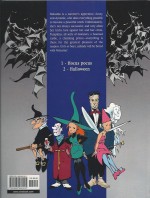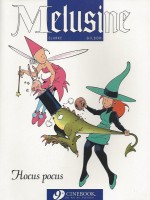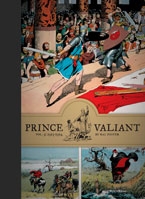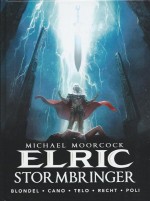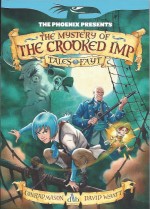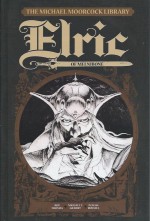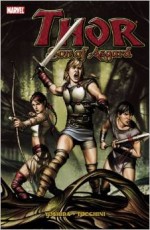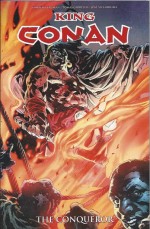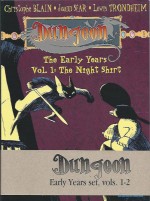
By Stan Sakai (Dark Horse Comics)
ISBN: 978-1-56971-375-8
Usagi Yojimbo first appeared in Stan Sakai’s The Adventures of Nilson Groundthumper and Hermy, in 1984’s furry ‘n’ fuzzy folk-fest Albedo Anthropomorphics #1. He soon graduated to a stirring solo act in Critters, Amazing Heroes, Furrlough and Munden’s Bar back-up strips in Grimjack.
In 1955, when Sakai was two years old, the family moved from Kyoto, Japan to Hawaii. Growing up in a cross-cultural paradise he graduated from the University of Hawaii with a BA in Fine Arts, before leaving the state to pursue further studies at Pasadena’s Art Center College of Design in California.
His early forays into comics were as a letterer – most famously for the inimitable Groo the Wanderer – before his nimble pens and brushes found a way to express his passion for Japanese history, legend and the filmic works of Akira Kurosawa and his peers, inspirationally transforming a proposed story about a human historical hero into one of the most enticing and impressive fantasy sagas of all time.
And it’s still more educational, informative and authentic than any dozen Samurai sagas you can name…
Although the deliriously expansive period epic stars sentient animals and details the life of a peripatetic Lord-less samurai eking out as honourable a living as possible by selling his sword as a Yojimbo (a bodyguard-for-hire – and, while we’re at it, “Usagi†literally translates as “rabbitâ€), the milieu and scenarios all scrupulously mirror the Edo Period of Japan – roughly 16th and 17th century AD by our reckoning – whilst simultaneously referencing other cultural icons from sources as varied as Zatoichi to Godzilla.
Miyamoto Usagi is brave, noble, industrious, honest, sentimental, gentle, considerate, artistic, empathetic, long-suffering and conscientious: a rabbit devoted to the tenets of Bushido, he is simply unable to turn down any request for help or ignore the slightest evidence of injustice. As such, his destiny is to be perpetually drawn into an unending panorama of incredible situations.
This evocative and enticing eleventh monochrome medieval masterpiece gathers Dark Horse Comics’ Usagi Yojimbo comicbook (volume 3) #7-12, and the hue-less, line art contents of Usagi Yojimbo Color Special #4 (Green Persimmon).
Following a fondly effusive Introduction from cartoonist Lynn (For Better or For Worse) Johnston, the ever-unfolding adventure resumes with ‘The Withered Field’ as our wandering hero watches swordmaster Nakamura Koji. The former fencing instructor to Lord Hikiji wants to test himself against Ueno, head of the Surodoi School, but the master is absent and his arrogant, haughty students refuse to summon him despite the old man’s succession of victories against them all…
Usagi had also desired to test his skills but instead listens to the incredibly dexterous Koji’s tragic story. Once an important warrior of impeccable status, he was bested in a duel by an unconventional itinerant samurai who rejected the traditional forms of fencing.
Shamed by the defeat Koji took up the Warrior’s Pilgrimage, travelling the land testing and perfecting his skill whilst preparing for a rematch.
As they chat sixteen Surodoi students ambush them, resolved to excise their failure by killing the wanderers. United against the dishonourable attackers, Usagi and Koji efficiently despatch them all and the swordmaster comments on his new friend’s unique combat style…
Once, Miyamoto was simply the son of a small-town magistrate before spending years learning the Way of Bushido from a stern, leonine master who was as much hermit as teacher. The lad learned not just superior technique and tactics, but also Katsuichi‘s creed of justice and restraint which would serve him well throughout his turbulent life…
When Ueno returns he is outraged by his disciples’ presumption and further incensed after finding the bodies of his prodigal pupils. He seeks out Koji and finds him calmly walking with a rabbit ronin. Determined to restore his good name, he grants Koji the long-deferred honour of a duel…
The battle is a wonder of form, grace and precision but upon its grisly conclusion the victorious Koji turns upon Usagi. Having seen his companion fight, the swordmaster has recognised the style which defeated him so long ago and must test himself against it once more.
Unable to dissuade him, the rabbit gives his utmost but is resoundingly defeated. Koji has no intention of killing him and instead tasks Usagi with carrying a message and challenge to his reclusive sensei: the triumphant swordmaster will meet Katsuichi a year hence at a specified place to decide finally and forever whose skill is the greatest…
‘A Promise in the Snow’ then sees the rabbit rover stumble upon a robbery and prevent the death of a merchant. The trader is grievously wounded however and his little daughter Fumiye begs the ronin to carry the rapidly expiring Araki to his home a half-day’s journey away.
The task is an arduous one over avalanche-prone mountains with starving wild beasts and numbing cold sapping his energies and good intentions with every step. Despite nigh-overwhelming odds little Fumiye insistently urges Usagi on, but when he finally brings Araki to safety the rescuer receives a stunning shock…
Political intrigue blossoms once again when a wounded messenger carrying an astounding document staggers into a temple in ‘The Conspiracy of Eight’. Inside Usagi is visiting his new friend Sanshobo and is present when the priest finds a pledge signed by eight High Lords agreeing to rise up against the Shogun. The messenger wears the livery of “Shadow Lord†Hikiji and has been struck down by assassin’s arrows…
Ambitious Hikiji’s name is not amongst the signatories and his role in the scheme cannot be guessed, but Sanshobo knows that the letter will result in great bloodshed whether the conspirators, Shadow Lord or Shogun possesses it. Proof of his contention comes when a band of samurai lay siege to the temple compound, demanding the surrender of the messenger…
As snows fall and temperatures plummet, priest, postulants and ronin enact a furious defence of the sanctuary but ultimately a lone ninja steals the document and brings it to an unsuspected fourth party with her own reasons for keeping it quiet.
Neko ninja clan-chief Chizu secretly prays that this time her erstwhile ally Usagi will keep his nose out of her business …
‘Snakes and Blossoms’ offers a brace of flashback tales wherein the Yojimbo, calmly recuperating as Sanshobo’s guest, finds a moment to share some old stories with his new friend.
‘Hebi’ harks back to a time when the ronin and his crusty companion Gennosuké (an irascibly bombastic, money-mad, bounty-hunting, conniving thief-taking rhino with a heart of gold) were caught in a storm and took shelter in an almost abandoned temple. Gen had to kill a huge, vicious snake to get there but once inside things became even more dangerous as the beast’s demon wife impersonated a nun to get close enough to exact vengeance…
A far more educational parable follows as ‘The Courage of the Plum’ reveals how impulsive student Usagi learned a life-lesson from Katsuichi-sensei one cold spring just as the winter snows began to melt…
After a rousing pin-up the drama recommences with ‘Return to Adachi Plain’ (inked by Sergio Aragonés) as the perpetual nomad’s path brings him back to the battlefield where his karma was decided forever…
Mere months after completing his tutelage with Katsuichi, Usagi was recruited to the personal retinue of Great Lord Mifunė. He advanced quickly and was soon a trusted bodyguard too, serving beside the indomitable and legendary Gunichi. It was a time of great unrest and war was brewing…
In his third year of service, the castle was attacked by Neko ninja assassins and, although the doughty heroes managed to save their master, the Lord’s wife Kazumi and heir Tsuruichi were murdered. Realising ambitious rival Lord Hikiji was responsible, MifunÄ— declared war…
The epic conflict ended on the great Adachigahara Plain when MifunÄ—’s general Todo switched sides and the betrayed Great Lord fell. At the crucial moment Gunichi also broke, fleeing to save his own skin and leaving Usagi to preserve the fallen Lord’s head – and honour – from shameful desecration…
With no master to serve, Usagi became a ronin and began his endless Warrior Pilgrimage…
Far away another portentous interlude occurs as a simple peasant is saved by a dark stranger from a cruel and murderous samurai as they all shared passage between islands in ‘The Crossing’.
Jei is a veritable devil in mortal form, believing himself a “Blade of the Godsâ€, chosen by the Lords of Heaven to kill the wicked. The maniac makes a convincing case: when he first met Usagi the diabolical spearman was struck by lightning and still survived.
Still pursuing his crusade against evil, Jei has adopted an orphan girl Keiko to aid him, but after saving a life he then perceives it to be an evil one too – as apparently is every other passenger on the unlucky vessel…
A fascinating exploration of warrior spirit is depicted as a defeated general goes deep undercover as farmer in ‘The Patience of the Spider’. Ikeda and his most trusted lieutenants survived the fall of their Lord, adopted a peasant lifestyle and are biding their time until they can rise again to expunge their shameful defeat.
But months turn to decades and the General fully grows into his new role – perhaps too much so…
Usagi resurfaces again when a band of cutthroats at an inn initially select him as a prospective victim before switching sights to another, more affluent-seeming traveller. The rogues soon learn the error of their ways as the enigmatic Oyama Tadanori wipes them out with ease.
Later the stranger encounters Usagi and the ronin recognises ‘The Lord of the Owls’ as an infamous cursed warrior reputed to be able to see death in a person’s eyes. He is not happy to hear the taciturn figure warn him that they will meet again…
More secrets of the Conspiracy of Eight are revealed in ‘The First Tenet’ when Chizu’s deputy Kagemaru exposes her part in the incriminating letter’s theft to Hikiji’s untrustworthy facilitator Lord Hebi. Infuriatingly some wily ninja has doctored the document and the conspirators remain practically anonymous…
Later, as Hebi’s entourage is attacked by assassins, Kagemaru just happens to be nearby with a band of faithful ninjas who rapidly despatch the assailants. It’s not so much the surprise of the counterattack that routs the rogues as shock that the man who hired them is now leading the defence of Hebi…
Attention returns to the Yojimbo as he passes the devastated mansion of Lady Takagi and recalls how, in the aftermath of the Dragon Bellow Conspiracy, he, Gen and female warrior Tomoe were rushing back to inform benevolent young Lord Noriyuki that the crisis had been averted.
After battling their way past hostile forces they were offered a night’s respite by the noble lady but ‘The Obakéneko of the Geishu Clan’ was a were-beast intent on murder and worse and it took all the ronin’s might and plenty of luck to survive until daylight…
The spellbinding storytelling concludes with espionage mystery ‘Green Persimmon’ as a dying samurai of Noriyuki’s Geishu clan entrusts Usagi with a strangely glazed ceramic fruit which simply must reach the young Lord at all costs.
The fragile porcelain artefact attracts the attention of numerous thugs, cutthroats and hired killers but as the Yojimbo carves his way across the country he is unable to fathom its purpose. Only when he meets Tomoe does the Green Persimmon surrender its incredible secret…
This medieval monochrome masterwork concludes with a ‘Gallery’ of seven superb covers to wrap things up with artistic aplomb.
Despite changing publishers a few times the Roaming Rabbit has been in continuous publication since 1987, with over 30 books and collections so far. He has guest-starred in many other series (most notably Teenage Mutant Ninja Turtles and its TV incarnation) and even almost made it into his own small-screen show.
There are high-end collectibles, art prints, computer games and RPGs, a spin-off sci-fi comics serial and lots of toys. Sakai and his creation have won numerous awards both within the Comics community and amongst the greater reading public.
Fast-paced yet lyrical, informative and funny, Usagi Yojimbo also bristles with tension and thrills and frequently breaks your heart with astounding tales of pride and tragedy.
Simply bursting with veracity and verve, it is the perfect comics epic: a monolithic magical saga of irresistible appeal to delight devotees and make converts of the most hardened haters of “funny animal†stories.
© 1996, 1997, 1999, 2004 Stan Sakai. Usagi Yojimbo is a registered trademark of Stan Sakai. All rights reserved.


